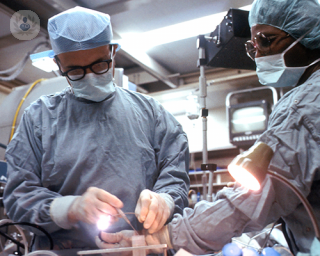Aortic stenosis
Dr Konrad Grosser - Cardiology
Created on: 06-26-2019
Updated on: 07-17-2023
Edited by: Conor Dunworth
What is aortic stenosis?
Aortic stenosis is a heart defect characterised by the narrowing of the aortic valve opening. In turn, this narrowing restricts the flow of blood from the left ventricle to the aorta. It can result either from a congenital birth defect or in ageing patients where scarring and calcium deposits build up in the valve opening. Treatment may require surgical valve repair or replacement.

What are the symptoms of aortic stenosis?
Sometimes aortic stenosis is asymptomatic but it depends on how severe the condition is in the individual. Some people may not experience any symptoms for many years but when they do, these may include:
- Breathlessness
- Chest pain (angina)
- Feeling dizzy or faint
- Heart palpitations
- Heart murmur - which is heard through a stethoscope
- Fatigue that is felt when exercising
What causes aortic stenosis?
The heart consists of four valves (mitral, tricuspid, pulmonary and aortic valves) that keep the blood flowing in the right direction. Each valve opens during a heartbeat but sometimes they do not open or close properly, which disrupts the blood flow to your heart.
The aortic valve between the lower left chamber and the main artery (aorta) becomes narrowed (stenosis) in the condition aortic stenosis. The left ventricle then has to work harder to make sure the blood pumps around the body, however, this causes it to thicken and enlarge. The extra work can lead to heart failure.
What are the risk factors for aortic stenosis?
Risk factors for the condition may include:
- Old age
- Congenital heart conditions
- Diabetes, hypertension or high cholesterol
- Chronic kidney disease
How is it diagnosed?
Aortic stenosis can be diagnosed using:
- Echocardiogram
- Electrocardiogram
- Chest X-ray
- Exercise tests
- CT scan
- Cardiac MRI
- Cardiac catheterization
How is aortic valve stenosis treated?
The treatment plan will be based on the individual case, depending on the severity of the condition and will be decided by the cardiologist.
If your symptoms are mild, the doctor will monitor your heart with regular check-ups and will suggest healthy lifestyle changes for you to make.
Surgery may be required in some cases in order to fix or replace the aortic valve.
Surgical procedure options include aortic valve repair, balloon valvuloplasty, aortic replacement (TAVR).














